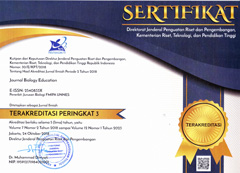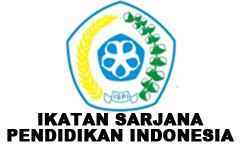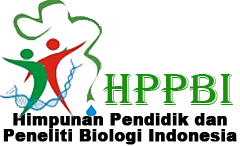HASIL BELAJAR KLASIFIKASI TUMBUHAN DENGAN MEMANFAATKAN KEBUN WISATA PENDIDIKAN UNNES
Abstract
This research was undertaken to improve the effectiveness of the biology learning process of the classification of plants by the use of Unnes biology garden for students of MTs. Al Asror. The method used was the pre experimental design with one-shot case study. Population was all class VII students at MTs. Al Asror Gunungpati Semarang, academic year 2011/2012. Samples were collected by random cluster sampling technique. The procedure included the preparation of the study (preliminary observations, the determination of the sample, making the learning devices, executed and analyzed field-testing results), and implementation (students were introduced with the classification of plant materials, the students were brought to the garden for observation and discussion, the students presented the results of the discussion, teachers conducted evaluation tests and analyze the test results). Data were obtained from the students worksheet, post test, the student activity sheet observations, observation sheets of teacher performance, as well as the questionnaire of students and teachers. Data were analyzed by descriptive quantitative and qualitative. The results showed that the learning outcomes of students during the learning process was 85% VIIA and 90% of students satisfied the minimum standard of learning achievement (KKM) VIIB ? 75. Based on the research results, it could be concluded that the results of students’ learning of the classification of plants by the use of the Unnes Biology Garden for MTs. Al Asror students were effectively characterized by the satisfaction of student learning outcomes ? 75. Students’ activity data also showed that learning could make students more active.
Penelitian ini dilaksanakan untuk mengefektifkan proses pembelajaran klasifikasi tumbuhan dengan memanfaatkan Kebun Wisata Pendidikan Unnes pada siswa MTs. Al Asror. Metode yang digunakan adalah pre experimental dengan desain one shot case study. Populasi diambil dari siswa kelas VII MTs. Al Asror Gunungpati Semarang tahun ajaran 2011/2012. Sampel diambil dengan teknik cluster random sampling. Prosedur penelitian meliputi persiapan ( observasi awal, penentuan sampel, membuat perangkat pembelajaran, melaksanakan dan menganalisis tes uji coba), dan pelaksanaan (siswa diberi materi klasifikasi tumbuhan, siswa dibawa ke kebun untuk pengamatan dan diskusi, siswa mempresentasikan hasil diskusi, guru mengadakan tes evaluasi dan menganalisa hasil tes). Data diperoleh dari Lembar Kerja Siswa, post test, lembar observasi aktivitas siswa, lembar observasi kinerja guru, serta angket tanggapan siswa dan guru. Data dianalisis secara deskriptif kuantitatif dan kualitatif. Hasil penelitian menunjukkan bahwa hasil belajar siswa selama proses pembelajaran adalah 85% siswa kelas VIIA dan 90% siswa kelas VIIB tuntas dengan KKM ? 75. Berdasarkan hasil penelitian dapat disimpulkan bahwa hasil belajar klasifikasi tumbuhan dengan memanfaatkan Kebun Wisata Pendidikan pada siswa MTs. Al Asror efektif yang ditandai oleh ketuntasan hasil belajar siswa ?75. Data aktivitas siswa juga menunjukkan bahwa pembelajaran tersebut dapat menjadikan siswa lebih aktif.
References
Ata, K. 2011. Pemanfaatan Lingkungan Sebagai media Pengajaran Biologi. http://www. artikel-pendidikan.com/. Diunduh tanggal 16 Maret 2012
Dimyati & Mudjiono. 2009. Belajar dan Pembelajaran. PT Rineka Cipta, Jakarta
Hidayati, D. 2008. Kebun Sekolah Sebagai Sumber Belajar. http://www. kebun-sekolah-sebagai-sumber-belajar.com/. Diunduh tanggal 15 Maret 2012
Hussein, H. 2012. Affordances of sensory garden towards learning and self development of special schooled children. International Journal of Psychological Studies. 4(1): 135-149
Lamanauskas, V. 2009. The process of natural science education in primary school: the importance of chemistry component. Journal of Research and Theoritical Studies. 19(1): 13-20
Nicol, R. 2003. Outdoor education: research topic or universal value? part three. Journal of Adventure Education and Outdoor Learning. 3(1): 11-28
Puasati, C. 2007. Peningkatan keterampilan proses dan pemahaman konsep biologi melalui pemanfaatan lingkungan sebagai sumber belajar siswa kelas x sma negeri 1 seputih agung tahun pelajaran 2006/2007. Jurnal Cakrawala Pendidikan. 6(1): 35-42
Rohani, A. 2004. Pengelolaan Pengajaran. PT Rineka Cipta, Jakarta
Slameto. 2010. Belajar dan Faktor-Faktor yang mempengaruhinya. PT Rineka Cipta, Jakarta
Sukarso & Cucum S. Taman sekitar lingkungan sekolah sebagai media pengajaran biologi. Jurnal Dinamika Pendidikan. 3(1): 53-60
Suwarno, W. 2008. Dasar-Dasar Ilmu Pendidikan. Ar-Ruzz Media Group, Jogjakarta
Syawiji, K.C. 2009. Metode outdoor learning dan peningkatan belajar aritmetika sosial. Jurnal Dinamika. 9(1): 30-46
Thomas, G. 2007. Skill instruction in outdoor leadership: a comparison of a direct instruction model and a discovery-learning model. Journal of Outdoor Education. 11(2):10-18
The copyright of the article once it is accepted for publication shall be assigned to the journal as the publisher. The intended copyright includes the right to publish the article in various forms (including reprints). The journal maintains the publishing rights to the published articles.
This work is licensed under a Creative Commons Attribution 4.0 International License.







